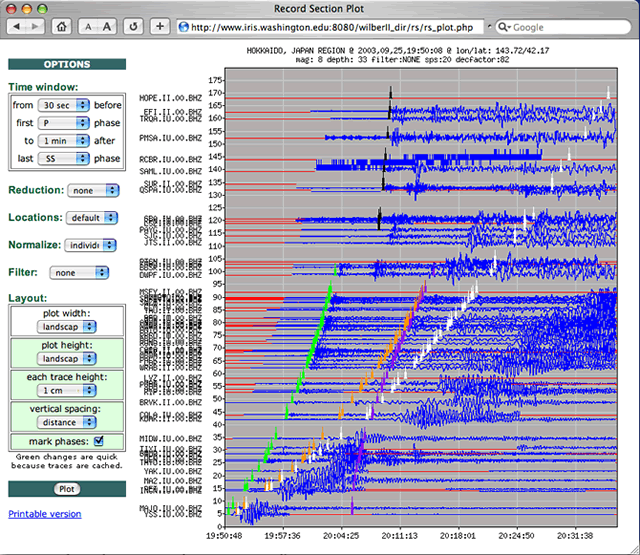New Record Section Plotting Page

Work was begun this summer on a new plot which will be available from both WILBER II and Seismic Monitor. The web page will produce record section-style plots of IRIS data holdings, allowing a WILBER II user to refine their data requests and a Seismic Monitor user to learn about earthquake travel times.
To avoid redundancy of function, the selection of stations to be plotted is still made from WILBER II. This way, whatever stations are being plotted are also the same stations that are being fed to the data request.
WILBER II users will also be able to select station ranges by distance and azimuth ranges. Three filters as well as instrument-value normalization will be provided. We plan to provide a “select N equal-interval” feature to aide in making nice plots. (Since travel time logic is already present, it would not be difficult to filter out any station which does not have some minimum signal located at one or more predicted phase arrival times).
For the educational user, a default record section plot will be created for all events over some minimum magnitude. This default plot will make use of the “n equal-interval” logic and will likely display 12 – 15 equally-spaced stations. These E&O plots will be saved so that only the first viewer will incur the delay of building the plot, and they will contain a link to the plot generation page for that event if a person wishes to explore further by generating their own plots.
On the topic of delays: how long does a plot take? It takes between 1 and 3 seconds per station, depending on the length of the time window and the miniSEED server load. (The miniSEED server will be covered in the next newsletter edition).
Project status
The plot page is operational and a user can pick a time window by specifying the desired start and ending phase arrivals, and can choose between plotting by distance from event or by equal “stack plot” intervals. Plot height and width can be expressed in centimeters/inches or as “portrait” and “landscape” dimensions. Velocity reduction is possible although it needs testing to verify its correctness. Record sections of upwards of 150 stations have been produced. While waiting, the web page gives constant feedback so the user knows how far along the job has progressed. Finally, caching has been implemented so that as many cosmetic changes as possible can be done without incurring another download delay from the miniSEED server.
Note that the plots being produced are PNG files, which are binary graphics files suitable for web and medium-quality hard copy. Conversion of the plot logic to allow a GMT-produced Postscript plot is a logical follow on to this work.
If you would like to try the beta page and provide feedback please contact Russ Welti
by Russ Welti (IRIS Data Management Center)






